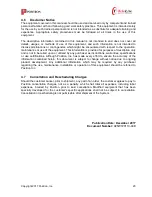
Copyright 2017 Positron, Inc.
5
2.0
Type 1 and Type 2 TeleLite Ethernet Configurations
An Ethernet configuration requires two cards; usually a Power Over Ethernet (POE) and Power
Serving Ethernet (PSE), however the same TeleLite Ethernet card can be used at each end of the
fiber span between the CFJ (Copper Fiber Junction) and Optical Electrical Interface depending on
local power arrangements, Network Ethernet Edge Devices and the terminating Ethernet modems.
2.1
Type 1a and Type 1b, General
In a
Type 1a
configuration, the TeleLite Ethernet card at the Central Office (C.O.) as the CFJ
(Copper Fiber Junction) and interfaces with the network Edge Devices, providing the Ethernet
service.
In a
Type 1b
configuration, the TeleLite Ethernet card as the CFJ (Copper Fiber Junction) is
located at the 300v Point of the GPR contour of the electric supply location and interfaces with the
network Edge Devices, providing the Ethernet service. See Figures 1 & 2.
2.1.1
Type 1a Detail
Locating the CFJ at the Central Office
2.1.2
Type 1b Detail
Locating the CFJ at the 300V point of the GPR contour of an electric supply location.
Model #720920xxx as OEI in
front of Ethernet modem
Model #720930xxx as CFJ at edge of
substation ZOI & Network Edge Device
Packet
Switched
Network
C.O.
NTWK
EDGE
DEVICE
NTWK
EDGE
DEVICE
NTWK
EDGE
DEVICE
NTWK
EDGE
DEVICE
Figure 2: Type 1b
10 Base-T / 100 Base-TX
Modem
CPE
CPE
CPE
CPE
10 Base-T / 100 Base-TX
300V
Point
Packet
Switched
Network
C.O.
NTWK
EDGE
DEVICE
NTWK
EDGE
DEVICE
NTWK
EDGE
DEVICE
NTWK
EDGE
DEVICE
Figure 1: Type 1a
10 Base-T / 100 Base-TX
Modem
CPE
CPE
CPE
CPE
10 Base-T / 100 Base-TX
300V
Point
Model #720920xxx as OEI in
front of Ethernet modem
Model #720930xxx as CFJ at edge of
substation ZOI & Network Edge Device





































